
Audacious Adventurer
The book Around the World in 80 Days was a work of fiction. This newspaper woman turned it into a reality as the nation followed along. Starting in New York, she raced through Europe, Asia, and then cross-country from California to New Jersey in record time. Join Nellie Bly on that November day in 1889 as she embarks on her 28,000 mile, 75 day adventure….
Her Ruby Shoe Moment
The Power of the Wand
Her Yellow Brick Road
Brains, Heart & Courage
Glinda’s Gallery
Just the Facts
Her Ruby Shoe Moment
On November 14, 1889, Nellie Bly marched up the gangway of the steamship, August Victoria. She looked down at her friends and colleagues, who came to the dock to see her off. And it finally hit her — Nellie was about to race around the world. Her goal was to travel 28,000 miles in 75 days and beat Phileas Fogg’s journey in the novel, Around the World in 80 Days, by Jules Verne.
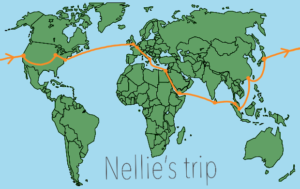 Nellie worked for Joseph Pulitzer’s newspaper, The World, as a journalist. The trip was a publicity stunt to increase newspaper sales. Nellie couldn’t wait to get going. She was ready to prove that a woman could travel around the world without the supervision of any man.
Nellie worked for Joseph Pulitzer’s newspaper, The World, as a journalist. The trip was a publicity stunt to increase newspaper sales. Nellie couldn’t wait to get going. She was ready to prove that a woman could travel around the world without the supervision of any man.
The August Victoria’s horn jolted Nellie from her thoughts. She synchronized her watch with the representative from the New York Athletic Club, who was the official timekeeper for her adventure. Moments later, the massive ship began to slowly pull away from the dock. Her official start time was 9:40:30 AM. The race was on!
After crossing the Atlantic, Nellie took the overnight Royal Mail train to London. Upon arrival, she learned that Jules Verne invited her to visit his home in France. It was worth the detour, since his novel inspired her journey. Then, Nellie took the Royal Mail train to Brindisi, Italy.
 Two steamships later, Nellie found herself halfway around the world in Singapore. And it was hot! She was closer to the equator than any other time on her journey. While exploring the city, Nellie bought a monkey — “McGinty” traveled home with her and wreaked havoc during the journey.
Two steamships later, Nellie found herself halfway around the world in Singapore. And it was hot! She was closer to the equator than any other time on her journey. While exploring the city, Nellie bought a monkey — “McGinty” traveled home with her and wreaked havoc during the journey.
The Oceanic took Nellie back to America — it held the record for the fastest crossing of the Pacific Ocean, so the captain was confident he could get Nellie to California on time. And he did. Despite bad weather, the Oceanic arrived in San Francisco a day early.
Nellie was thrilled to be back on American soil, but soon learned about the next challenge to her journey. The American West experienced its worst snowstorm in 10 years and her route to New York City was impassable. So The World chartered a train to take Nellie on the southern route from Oakland to Chicago.
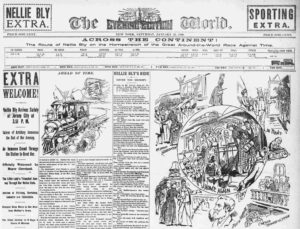
“The World Extra” Evening Edition, Saturday January 25, 1890 (featuring Nellie’s arrival home)
The World spared no expense. Her private train cost more than the rest of her trip combined. It had only two cars — a steam engine and a Pullman sleeping car. And it was given priority over every other train on the tracks. One of the engineers even allowed Nellie to drive the train, which was a highlight of her entire trip. Nellie arrived in Chicago in record time (literally).
As Nellie crossed America, she realized that the entire nation had followed her journey. Nellie was welcomed home by thousands of people as her train pulled into Jersey City. She scanned the crowd and found the timekeeper from the New York Athletic Club — he recorded the very moment she stepped off the train.
Nellie reached the finish line! She traveled around the world in 72 days, 6 hours, 11 minutes and 14 seconds. And her life was forever changed.
The Power of the Wand
Nellie was a pioneer in journalism and paved the way for future generations of women. She proved that women could hold their own in a “man’s world” and need not be limited to society’s expectations. Over the years, many women have followed in Nellie’s footsteps — they have chosen their own path, exposed injustices in the world, and inspired change.
For example, Bana al-Abed told the world via Twitter what life was really like in war-torn Syria. When she was seven years old, Bana posted about their struggles to survive in Aleppo. She shared their lack of food and water, losing their home in an airstrike, and the death of her father and brother. Her posts gained international attention and highlighted the suffering of Syrian children. Bana and her mother were evacuated from Aleppo in 2017 and now live in Turkey. In 2018, Bana wrote a book, Dear World, about her experiences.
Her Yellow Brick Road
Nellie first suggested a trip around the world about one year before she got the assignment. Her original proposal was to travel in the steerage of a ship, to show what it was like for immigrants to make the journey to America.
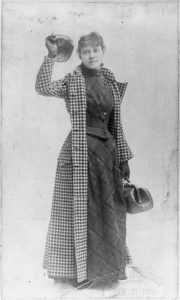
Nellie in her traveling clothes and small satchel (Library of Congress)
At first, the newspaper refused — it wasn’t proper for women to travel alone. They discussed sending a man, but Nellie protested. It was her idea. She even threatened to race the man around the world, and win. Nellie never gave up and pushed management until they relented. The World agreed to the trip just a few days before Nellie’s departure, so the preparations were a complete whirlwind.
Her most urgent need was a passport — one of her colleagues traveled to Washington DC and hand-delivered her application. It wouldn’t be ready by the time she departed, so they arranged for the passport to be delivered to the American consulate in London.
Nellie traveled very light, since she wanted the independence that came along with carrying her own luggage. She had a traveling dress custom-made within 24 hours and bought a long coat and a few hats. She carried only a small leather satchel, which contained her toiletries, a change of clothes, and writing supplies. It was shocking to some people, since most women traveled with multiple trunks back then.
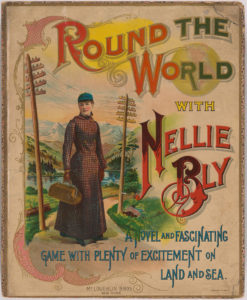
Nellie Bly Board Game (National Portrait Gallery, Smithsonian Institution)
The trip was to be representative of how long it would take a typical traveler to circle the globe. Nellie could use only the “ordinary lines of commerce” (no chartered boats to make up for lost time). She planned to use British money, but also brought some American dollars to see if they would be accepted anywhere. And she would try to accomplish the trip by speaking only English.
Nellie mapped out her route — from New York to Europe, across the Mediterranean Sea and through the Suez Canal. Then, over the Arabian Sea to Hong Kong and across the Pacific Ocean to San Francisco. Finally, she would take a train back to New York. For the most part, she followed the British Royal Mail as it traveled from colony to colony. She bought passage to England, but had to purchase tickets for the rest of her trip in London.
Less than 48 hours after The World agreed to her trip, she was on her way to board a steamship and take on the world by herself.
Brains, Heart & Courage
 Nellie became a journalist through grit and determination. She grew up in a small mining town in Pennsylvania and had no formal education (except one semester at boarding school). Nellie’s father died when she was 6 years old and she watched her mother struggle to make ends meet.
Nellie became a journalist through grit and determination. She grew up in a small mining town in Pennsylvania and had no formal education (except one semester at boarding school). Nellie’s father died when she was 6 years old and she watched her mother struggle to make ends meet.
Luckily, Nellie got her big break in 1885 after reading an article in the Pittsburgh Dispatch entitled “What Girls Are Good For.” It claimed that women’s only purpose was to keep a home and raise a family. Nellie was furious and wrote a letter to the editor, signing it Little Orphan Girl. The editor was impressed and offered her a job.
Nellie worked at the Pittsburgh Dispatch for a few years, but never received the serious assignments she craved. So Nellie decided it was time for something bigger and moved to New York City.
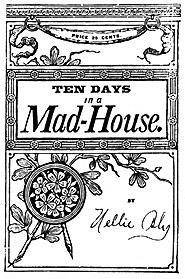 Nellie’s very first assignment at The World was to go undercover at the Women’s Lunatic Asylum on Blackwell’s Island. The newspaper received a tip that its female patients were abused and neglected. So Nellie pretended to be mentally ill and was admitted as a patient. She experienced the miserable conditions firsthand — abusive nurses, freezing-cold showers, and no towels. Thankfully, The World hired a lawyer to get her discharged 10 days later.
Nellie’s very first assignment at The World was to go undercover at the Women’s Lunatic Asylum on Blackwell’s Island. The newspaper received a tip that its female patients were abused and neglected. So Nellie pretended to be mentally ill and was admitted as a patient. She experienced the miserable conditions firsthand — abusive nurses, freezing-cold showers, and no towels. Thankfully, The World hired a lawyer to get her discharged 10 days later.
Her report on the asylum shocked the public and shamed politicians into making reforms. It also earned her a permanent position at The World. Before long, Nellie became a pioneer in the field of investigative journalism, writing stories that exposed corruption and defended the working class.
Glinda’s Gallery
Visit Nellie’s digital scrapbook on Pinterest.
Just the Facts
- Elizabeth Jane Cochran was born on May 5, 1864. “Pink” was her nickname while she was a girl and “Nellie Bly” was her pen name. She frequently claimed to be a few years younger than she really was.
- Nellie’s adventure inspired the creation of a board game, a copy of which is held by the National Portrait Gallery.
- Nellie worked at a few different newspapers over the years, including the Chicago Times-Herald. In fact, she investigated the Pullman Strike in Chicago in 1895 — some think it was her best work. She also traveled to Austria in 1914 to report on the events of World War I.
- During her Chicago trip, Nellie met millionaire Robert Seaman (he was about 40 years older than she). And they eloped two weeks later. The marriage had a rocky start, but eventually became a source of happiness for Nellie.
- After Seaman passed away, Nellie took over his interest in the Iron Clad Manufacturing Company. She improved the working conditions for its employees and introduced new ideas into the business. The company ran into financial difficulties, however, and eventually declared bankruptcy.
- Nellie held over 20 patents, including the invention of a metal barrel in 1905 — most steel oil drums use the same design today.
- Nellie died of pneumonia in 1922 at 57 years old. Her last newspaper column was published just a few days earlier.
- Nellie was inducted into the National Women’s Hall of Fame in 1998.
- Nellie was featured on a US postage stamp in 2002.
- In 2019, a design was selected for a memorial of Nellie Bly on Roosevelt Island, near the sight of the infamous Blackwell’s Island Lunatic Asylum. “The Girl Puzzle” will hopefully be unveiled in late 2020.
- Nellie has been featured in a few movies, including “10 Days in a Madhouse,” released in 2015.
Want to Know More?
Bly, Nellie. Around the World in 72 Days. New York: Pictorial Weeklies, 1890 (accessed at http://digital.library.upenn.edu/women/bly/world/world.html).
Bly, Nellie. Ten Days in a Madhouse. New York: Pictorial Weeklies, 1890 (accessed at https://digital.library.upenn.edu/women/bly/madhouse/madhouse.html).
Goodman, Matthew. Eighty Days: Nellie Bly and Elizabeth Bisland’s History-Making Race Around the World. New York: Ballantine Books, 2013.
Kroeger, Brooke. Nellie Bly: Daredevil, Reporter, Feminist. New York: Times Books, 1994.
Nellie Bly of the New York World. Undercover Reporting, Deception for Journalism’s Sake: A Database. New York University (accessed at dlib.nyu.edu/undercover/nellie-bly-new-york-world-0).
Nellie Bly Articles. Historic Journalism (accessed at www.historicjournalism.com/nellie-bly.html).
Nellie Bly: A Resource Guide. Library of Congress (accessed at https://guides.loc.gov/nellie-bly).
Remarkable Nellie Bly’s Oil Drum. American Oil & Gas Historical Society (accessed at https://aoghs.org/transportation/nellie-bly-oil-drum/).
American Experience: Around the World in 72 Days. PBS Broadcasting, 1997 (accessed at https://www.pbs.org/wgbh/americanexperience/films/world/).
Nellie Bly: The Virtual Reality Experience (accessed at https://www.viveport.com/apps/fb3a800b-e70f-477e-b37a-bbb035c73e41/Nellie_Bly:_The_Virtual_Reality_Experience/)
